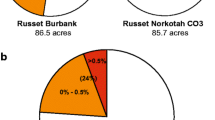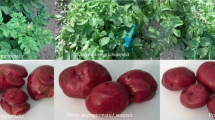Abstract
Five fresh market potato cultivars commonly grown in western Washington were evaluated against Potato virus Y (PVY) O, NTN, and N-Wi using inoculated PVY-free plantlets in the greenhouse in 2015 and successive generations of seed tubers from foliar inoculated plants in 2016, 2017, and 2018. Mosaic displayed strongly on all cultivar by strain combinations, except All Blue by PVYO. Russet Burbank and Yukon Gold infected with PVYO had highest area under symptom progress curve values for leaf drop across all cultivars and years. Yields mostly were lowest for PVYO. More cracked tubers developed on G3 tubers in the field than greenhouse G2 or G1 plants. Chieftain infected with PVYO and PVYNTN, and Yukon Gold with PVYN-Wi had marked increases in tuber cracking by 2018. Cracking began at early plant growth stages; seed tuberborne rather than current season infections had higher cracking incidence; cracking became prevalent with succeeding seed tuber generations; cracking did not contribute to tuber weight loss during storage; and, PVY and tuber cracking substantially impacted yield.
Resumen
Se evaluaron cinco variedades de papa para mercado fresco que se cultivan comúnmente en el occidente de Washington, contra el virus Y de la papa (PVY) O, NTN, y N-Wi, utilizando plántulas inoculadas que estaban libres del virus en invernadero en 2015, así como a generaciones sucesivas de tubérculos-semilla de plantas inoculadas en la hoja en 2016, 2017 y 2018. Se presentó muy fuerte el mosaico en todas las variedades por la combinación de variantes, excepto All Blue por el PVYO. Russet Burbank y Yukon Gold infectadas con PVYO tuvieron los valores más altos del área bajo la curva de progreso de los síntomas para caída de las hojas en todas las variedades y años. Los rendimientos en su mayoría fueron los más bajos para PVYO. Se desarrollaron más tubérculos cuarteados en tubérculos G3 en el campo que plantas de G3 o G1 en el invernadero. Chieftain infectada con PVYO y PVYNTN, y Yukon Gold con PVYN-Wi tuvieron aumentos marcados en tubérculos cuarteados en 2018. El cuarteado empezó en etapas tempranas del crecimiento de la planta: Las infecciones por semilla, en vez de las normales del ciclo, tuvieron mayor incidencia de cuarteado; el cuarteado se volvió prevalente con generaciones subsecuentes de tubérculo-semilla; el cuarteamiento no contribuyó con la pérdida de peso del tubérculo durante el almacenamiento, y el PVY y las cuarteaduras de tubérculo impactaron substancialmente el rendimiento.




Similar content being viewed by others
References
Beissinger, A., and D. Inglis. 2018. Greenhouse comparison of two detection methods for Potato virus Y at four potato growth stages. Plant Health Progress 19: 71–75.
Beissinger, A., Benedict, C., and D. Inglis. 2018. Alternative sources of Potato virus Y in western Washington. Washington State University Extension Publication TB49E. 25.
Benedict, C.A., D.W. McMoran, D.A. Inglis, and A.V. Karasev. 2015. Tuber symptoms associated with recombinant strains of Potato Virus Y in specialty potatoes under western Washington growing conditions. American Journal of Potato Research. 92: 593–602.
Blauer, J.M., L.O. Knowles, and N.R. Knowles. 2013. Manipulating stem number, tuber set and size distribution in specialty potato cultivars. American Journal of Potato Research 90: 470–496. https://doi.org/10.1007/s12230-013-91370.
Boonham, N., K. Walsh, S. Preston, J. North, P. Smith, and I. Barker. 2002. The detection of tuber necrotic isolates of Potato virus Y and the accurate discrimination of PVYO, PVYN, and PVYC strains using RT-PCR. Journal of Virological Methods 102: 103–112.
Boyd, E., E. Carpenter, B.T. Ross, N. Zidak, and M.L. Flenniken. 2018. Potato cultivar and seed type affect the development of systemic Potato virus Y (PVYN-Wi) infection. American Journal of Potato Research 95: 183–190 ADD.
Carnegie, S.F., and M. McCreath. 2010. Mosaic virus symptoms in potato crops and the occurrence of growth cracking in tubers. Potato Research 53: 17–24.
Chikh-Ali, M., S.M. Gray, and A.V. Karasev. 2013a. An improved multiplex IC-RT-PCR assay distinguishes nine strains of Potato virus Y. Plant Disease 97: 1370–1374.
Chikh-Ali, M., A.V. Karasev, N. Furutani, M. Taniguchi, Y. Kano, M. Sato, T. Natsuaki, and T. Maoka. 2013b. Occurrence of Potato virus Y strain PVYNTN in foundation seed potatoes in Japan, and screening for symptoms in Japanese potato cultivars. Plant Pathology 62: 1157–1165.
Crosslin, J.M., P.B. Hamm, K.C. Eastwell, R.E. Thornton, C.R. Brown, D. Corsini, P.J. Shiel, and P.H. Berger. 2002. First report of the necrotic strain of Potato virus Y (PVYN) potyvirus on potatoes in the northwestern United States. Plant Disease 86: 1177.
Crosslin, J.M., P.B. Hamm, K.S. Pike, T.M. Mowry, P. Nolte, and H. Mojtahedi. 2008. Managing diseases caused by viruses, Viroids, and Phytoplasmas. In Potato health management, ed. D.A. Johnson, 161–169. St. Paul: The American Phytopathological Society.
Fry, W.E. 1977. Integrated control of potato late blight: Effects of polygenic resistance and techniques of timing fungicide applications. Phytopathology 67: 415–420.
Funke, C.N., O.V. Nikolaeva, K.J. Green, L.T. Tran, M. Chikh-Ali, A. Quintero-Ferrer, R.A. Cating, K.E. Frost, P.B. Hamm, N. Olsen, M.J. Pavek, S.M. Gray, J.M. Crosslin, and A.V. Karasev. 2017. Strain-specific resistance to Potato virus Y (PVY) in potato and its effect on the relative abundance of PVY strains in commercial potato fields. Plant Disease 101: 20–28.
Gudmestad, N.C. 2008. Potato health from sprouting to harvest. In Potato health management, ed. D.A. Johnson, 67–77. St. Paul: The American Phytopathological Society 259 p.
Inglis, D.A., B. Gundersen, and A. Beissinger. 2016. Evidence that tuber cracking in potato can be caused by Potato virus Y. Phytopathology 106: S4.199 (Abstract).
Inglis, D., C. Benedict, B. Gundersen, A. Beissinger, and D. McMoran. 2018a. Proactive approaches for controlling recombinant strains of Potato virus Y in western Washington. WSU Extension Fact Sheet: 313E. 13.
Inglis, D.A., B. Gundersen, A. Beissinger, C. Benedict, and A.V. Karasev. 2018b. Potato virus Y in seed potatoes sold at garden stores in western Washington: Prevalence and strain composition. American Journal of Potato Research 96: 235–243.
Jones, R.A.C., and S.J. Vincent. 2018. Strain-specific hypersensitive and extreme resistance phenotypes elicited by Potato virus Y among 39 potato cultivars released in three world regions over a 117-year period. Plant Disease 102: 185–196.
Karasev, A.V., and S.M. Gray. 2013. Continuous and emerging challenges of Potato virus Y in potato. Annual Review of Phytopathology 51: 571–586.
Karasev, A.V., O.V. Nikolaeva, X. Hu, Z. Sielaff, J. Whitworth, J.H. Lorenzen, and S.M. Gray. 2010. Serological properties of ordinary and necrotic isolates of Potato virus Y: A case study of PVYN misidentification. American Journal of Potato Research 87: 1–9.
Kerlan, C., O.V. Nikolaeva, X. Hu, T. Meacham, S.M. Gray, and A.V. Karasev. 2011. Identification of the molecular make-up of the Potato virus Y strain PVYZ: Genetic typing of PVYZ-NTN. Phytopathology 101: 1052–1060.
Lang, N.S., R.G. Stevens, R.E. Thornton, W.L. Pan, and S. Victory. 1999. Nutrient management guide: Central Washington irrigated potatoes. Washington State University Cooperative Extension Bulletin 1882. Pullman, WA.
McMoran, D. 2018. Skagit County Agriculture Statistics, 2017. WSU Skagit County Extension. https://s3.wp.wsu.edu/uploads/sites/2073/2018/07/ag-stats-2017.pdf
Pavek, M.J., Z.J. Holden, R.R. Spear, and B.J. Weddell. 2018. Improving land use efficiency and grower revenue by reducing potato row width. American Journal of Potato Research 95: 451–462. https://doi.org/10.1007/s12230-018-9645-1.
Rosenman, J., C.S. McIntosh, P. Nolte, and G. Raj Aryal 2019. Planting a problem-examining the spread of seed-borne Potato virus Y. Plant Disease online.
Rowley, J.S., S.M. Gray, and A.V. Karasev. 2015. Screening potato cultivars for new sources of resistance to Potato virus Y. American Journal of Potato Research 92: 38–48.
USDA (Natural Resources Conservation Service). 2008. Web Site for Official Soil Series Descriptions and Series Classification, Shano Series. https://soilseries.sc.egov.usda.gov/OSD_Docs/S/SHANO.html.
Washington Certified Seed Potatoes. 2019. Washington Seed Potato Crop Directory, https://www.waseedpotato.com/crop-directory.
Acknowledgements
This research was made possible by the Northwest Potato Research Consortium, WSDA Specialty Crop Block Grant Program, Project K1509; and, USDA-NIFA-Specialty Crops Research Initiative CAPS, Project 2014-07878. We thank Abby Beissinger, Lori Ewing, Cassandra Funke, Stewart Gray, Zachary Holden, and Lydia Tymon for advice, technical assistance, and/or manuscript review.
Author information
Authors and Affiliations
Corresponding author
Rights and permissions
About this article
Cite this article
Gundersen, B., Inglis, D.A., Pavek, M. et al. Foliar and Tuber Reactions of Three Strains of Potato virus Y on Five Fresh Market Potato Cultivars through Three Successive Potato Generations. Am. J. Potato Res. 96, 519–531 (2019). https://doi.org/10.1007/s12230-019-09738-3
Published:
Issue Date:
DOI: https://doi.org/10.1007/s12230-019-09738-3




